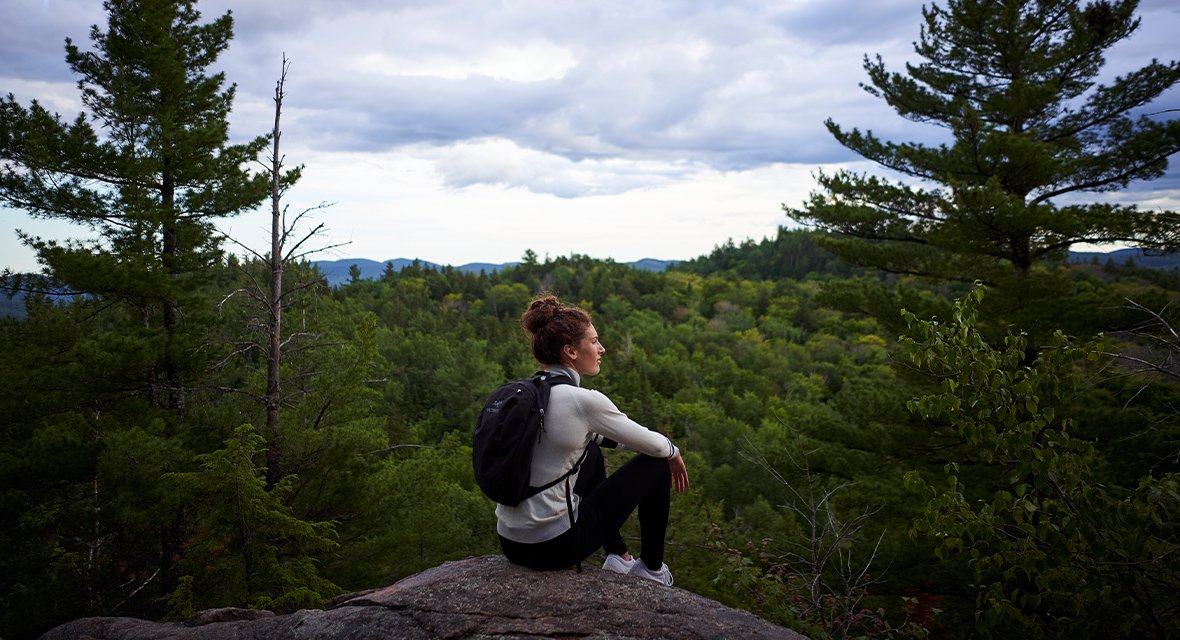
How to prepare for a hike
Outdoor lovers know that enjoying a great hike is all in the preparation. Whether you’re heading out on an afternoon, all-day or five-day excursion, take the time to prepare yourself well so that you get the most out of it. In addition to researching the trail and checking the weather before embarking, you also want to have a good idea of your physical abilities and make sure you have the proper clothing, gear and backpack items for peace of mind.
The right hiking footwear for you
Dressing properly from head to toe for your trek is key. If you’re going for a short hike or a day-trip, you can wear lightweight low- or mid-cut hiking shoes or boots, which are also easier to wear for beginners. If you’re heading out on a more ambitious trek, you should wear boots with a higher ankle cuff to support and protect your ankles on any kind of terrain you take on. The ideal hiking footwear is waterproof and has good trail-gripping treads, while above all being comfortable. Hiking is not like a short stroll in town when you can live with a little discomfort. Uncomfortable footwear becomes a real nightmare after just a few hours of hiking.
— One step in front of the other —
Clothes made for the outdoors
The proper dress for hiking success is lightweight, comfortable clothes that allow you to move freely and unconstrained. You also want them to dry quickly in case you get rained on. If you’re going on an expedition of more than a day, the weather may change dramatically, so always bring a few changes of clothing. You should pack warm clothes for nights, lighter clothes for the day and of course headwear to protect you from the sun.
Essential backpack items
A 35-litre backpack is perfect for a day hike. A good rule of thumb is that your pack should not exceed 20% of your body weight. Make sure to spread the weight out evenly in the pack with the most useful things in easy reach. Although the list of essentials varies depending on whether you leave for a day or a week, they remain: sunglasses, sun cream, toilet paper, first-aid kit, water, food, map and GPS or compass. And don’t forget a bag for trash so that you don’t leave any litter behind. If you’re taking a longer trek, bring along a survival blanket, spare laces and one or more walking sticks.
— Take what's essential —
Complete first-aid care package
Don’t skimp on first-aid preparation. It doesn’t take long to get a painful blister, for example, and there are plenty of other injuries big and small that you or your hiking partner or partners may encounter. Your kit should include disinfecting wipes, gauze pads, bandages, mosquito repellent, suture tape and tweezers. Don’t forget to pack any medication that you regularly take.
Keep hydrated and eat smart
The primary energy objective is to maintain a consistent level of sugar throughout the hike. A light diet of slow sugars, such as pasta, is excellent for long treks. Eat full meals in the days before your hike, and avoid fast sugars, which actually lower the blood sugar level and cause a drop in energy. Nuts, dried fruits and granola bars are great. Of course, as with any physical effort, you need to regularly top your body up with water: bring along at least 1.5 litres.
If you’re a beginner, start with a day hike, then add one day at a time. If you follow these tips to properly prepare, you’ll be ready for anything and have maximum fun.
Happy trails!
— A walk in the park —
If reading this made you want to take a hike, here is our selection of trails for longer hikes through epic Quebec landscapes:
Mont-Tremblant National Park
Outdoor enthusiasts know this is a gorgeous national park with trails that offer three- to five-day hikes. Nature-lovers adore the park for the diversity of its fauna and flora. The vast expanse of lakes and rivers is home to deer, wolves, beavers, hares and bears. The hiking circuit covers 120 kilometres of trails that offer ten communal huts with a capacity of two to 18 people. Details >>
Monts-Valin National Park
Officially opened in 2011, this park offers three epic trails for two- to four-day treks: Le Pic-de-la-Tete-de-Chien, Le Pic-du-Grand-Corbeau and Le Pic-de-la-Hutte. Over twenty-five kilometres of trails cross the entire park through a variety of terrains, and the highest point sits at an altitude of 980 metres to offer an exceptional view of the landscape. Details >>
Saguenay Fjord National Park
If you’re an experienced hiker, this network of trails is for you. With over 100 kilometres to hike, you can get away from it all for two to nine days. On the Sentier Le Fjord trail, three comfortable huts with balconies give an unobstructed view of the coves and bays below. From your window, you can watch beluga whales swim down to Baie Sainte-Marguerite. Breathtaking! Details >>






